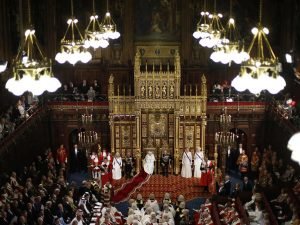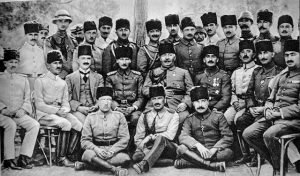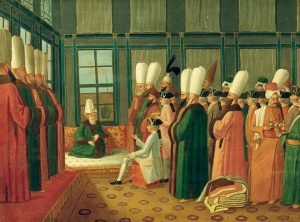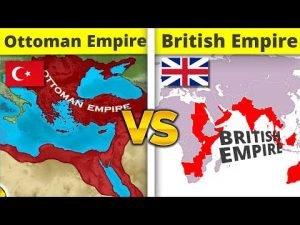In the Ottoman Empire, How Did The Monarchy Come to An End While It Continued in Britain?

The monarchy is a form of government in which a country is ruled by a dynasty or an individual. Throughout history, many principalities, states, and empires have been established under this system. While some of these dynasties, states, or empires established through this system were short-lived, others endured for many years. The Ottoman Empire and the British Empires were both structures where this system existed. When their histories are examined, it can be observed that both structures maintained their existence for centuries. However, while the Ottoman Empire ceased to exist with the abolition of the sultanate in 1922, the British Empire, although gradually losing power, still maintains its monarchy structure. The continuation of one of the two long-lasting monarchy structures in two different geographical locations and the failure of the other generally have historical reasons.

The abolition of the sultanate was officially realized with Decree No. 308, titled “The Turkish Grand National Assembly’s Decision that it is the True Representative of Lawful Sovereignty and Sovereignty,” accepted by the Turkish Grand National Assembly on November 1, 1922 (Oral, 1996). With this decree, the Ottoman Empire officially came to an end. The concrete reason that led to this decision, which paved the way for it, was the joint invitation of the Ankara and Istanbul governments to the peace conference planned to be held after the successful conclusion of the War of Independence.
The Turkish Grand National Assembly, which gathered on October 28 to abolish the sultanate, could not reach a conclusion, but the sultanate was abolished under the influence of Mustafa Kemal. According to Mustafa Kemal’s statements in his “Nutuk” (Speech), “He met with Rauf and Refet Bey and had many discussions with them, and appointed them to the assembly for the abolition of the sultanate” (Aslan, 2002). As a result, the sultanate and the caliphate were separated, and the last Sultan, Vahdettin, left for Malta on the morning of November 17 aboard a British warship. On November 19, Abdülmecid was declared the caliph by the Turkish Grand National Assembly. Although this event explains how the sultanate was abolished in the Ottoman Empire, there were different reasons behind the abolition of the sultanate. The invitation of representatives from both sides to the London Conference can be described as the tip of the iceberg. First, by examining these reasons, understanding why the monarchy disappeared from Turkish borders, and then examining the reasons for the existence of monarchy in Britain, the reflections of these two structures in two different geographical locations can be better understood.
So why was monarchy abolished in the Turkish region?
I.
The first reason for this is the diplomatic and military victories achieved by the Turkish Grand National Assembly, while the Sultan and the Istanbul government remained dysfunctional and continued to exist, causing divisions in the state. In many sources, it is mentioned that with the occupation of Istanbul on March 16, 1920, the Ottoman Empire effectively came to an end. Although the Ottoman Empire had ended with the occupation, it had not legally ceased to exist, and almost all institutions continued to exist directly under the Istanbul government and the Sultan. The dysfunctionality of the Istanbul government and the continuation of a system like a state within a state caused problems in diplomacy and public affairs. The Lausanne Peace Conference is considered the most significant manifestation of these divisions, but such divisions were experienced in many other areas as well. The increase in these divisions and the creation of divisions in an event like the Lausanne Peace Conference, which would influence the fate of the country, brought an end to the institution of monarchy and the Istanbul government.
II.
Another important reason for the abolition of the sultanate is the policies pursued by the Istanbul government towards the Ankara government before, during, and after the War of Independence. Before the war, the Istanbul government, which was restricted by the Allied powers, dismissed officers who opposed it and even attempted to assassinate Mustafa Kemal Pasha. However, its pro-allied and protective policies throughout the war influenced the Ankara government’s attitude towards the sultanate as well. During and after the War of Independence, rebellions occurred in certain provinces, such as Yozgat, Afyon, Konya, and Düzce, which were supported by the Istanbul government, causing financial and spiritual distress for the Ankara government. The recurrence of such incidents led to a change in the Ankara government’s stance and became one of the reasons for the abolition of the sultanate.

III.
The third and final reason is that the members of the Turkish War of Independence cadre were influenced by republican and democratic ideas from their youth. Turkish officers were born in the second half of the 19th century. From the moment they were born, they found themselves within the republican and national sovereignty ideas. Due to the environment in which they were born and raised, most of the Turkish War of Independence officers believed that not only the Sultan but also the people should have a say in the state. However, Mustafa Kemal Pasha and a few Turkish officers who thought like him took these ideas a step further and envisioned a state order where the people were sovereign. When these dreams combined with the other two concrete reasons, they went beyond the realm of dreams and led to the abolition of the sultanate and even the proclamation of the republic a year later. These three main reasons explain why a system change took place in Anatolia, or rather in Turkey. However, the fact that the monarchy still continues in Britain alongside these reasons brings about a comparison.
How does the same system create different scenarios in different geographical locations?
I.
When considered in comparison, the first criterion is the symbolic status. The absolute monarchy system in the UK ended after the execution of Charles I in January 1649, and Britain embraced republicanism as the main element. Since the day this event took place, the progressing republic has become fully established in Britain. In such a system, the monarchy and the royal family exist only symbolically. Due to their symbolic presence, they do not interfere in legislative matters and stay away from politics. For example, during World War II, the Queen provided moral support to the people and encouraged them to protect their country. However, the elected government led by Winston Churchill conducted the war on behalf of Britain. It is not possible to say the same for Turkey. During the War of Independence, in addition to symbolically standing, the Istanbul government exhibited various rebellions and dissenting behaviors against the Ankara government. From this perspective, there is a system that accepts the monarchy symbolically and acts accordingly on one side, and on the other side, there is a system that acts in the opposite way.
II.
The second criterion is stability. For example, Queen Elizabeth II, who has been the leader of the British monarchy for nearly seventy years, witnessed the Vietnam War, the collapse of the USSR, the September 11 attacks, and even the global COVID-19 pandemic. In addition to these universal events, she has seen about ten different prime ministers within her country’s borders. Many of these prime ministers have mentioned in their memoirs and ordinary meetings that they found the exchange of ideas with her very productive, that they knew she was not taking sides, and that they felt comfortable with her experience (Ashley, 1998). In contrast, in the Ottoman Empire, the average tenure of the sultans after the 17th century was twelve years. Unlike the glory days of the state, this average during a period of turmoil demonstrates a lack of stability. Although it did not have a significant impact on the abolition of the sultanate, the reason why the British Monarchy has survived is this stability and its guidance.
III.
The third element is the attitude of the people and the conditions within the states themselves. Despite some loss of support after the death of Lady Diana, the British monarchy is still backed by a large number of people. The British monarchy has often received support from the people, even in situations such as the events in India and Ireland. Another perspective is that despite certain significant territorial losses, the British monarchy has never lost its power. In the Ottoman Empire, on the other hand, there was a decline and eventually a period of collapse since the 17th century. This is one of the reasons why the support of the people differed in the two different monarchies.

Author’s Note
In conclusion, while the sultanate was abolished in Anatolian lands in the first quarter of the 20th century, the monarchy in Britain continued, albeit with diminishing power. The reasons behind the abolition of the sultanate include the inner world of officers and the divisions within the state hierarchy. The important outcome to be drawn from this is that historical events cannot be prevented from progressing as a process. The essence of all these reasons is “time.” As an empire loses its power over time, another gains strength. Therefore, the understanding of monarchy has also diversified. In Anatolia, the abolition of the sultanate began to be perceived as a necessity, and the idea that many negative outcomes were caused by monarchy became widespread. In Britain, despite occasional stagnation, the process has been positive, which has rendered questioning the monarchy ineffective. Engaging in the discussion of “What if it had stayed?” by delving into these problems and reasons would be a risky examination.
Author: Ahmet Gül
Editor: Emine Türal
References:
- Ashley, M. (1998). The Mammoth Book of British Kings and Queens. London: Robinson.
- Aslan, B. (2002). Saltanatın Kaldırılmasının İstanbul’daki Yankıları. Belleten, 95-122.
- Atay, F. R. (2009). Çankaya. İstanbul: Pozitif Yayıncılık.
- Doğan, D. M. (2013). Türkiye Cumhuriyeti Tarihine Giriş. Ankara: Yazar Yayınları.
- Kansu, M. M. (2019). Erzurum
dan Ölümüne Kadar Atatürkle Beraber I-II. Ankara: Türk Tarih Kurumu. Lewis, B. (2008). Modern Türkiye’nin Doğuşu. Arkadaş Yayıncılık. - Oral, M. (1996). Ulusal Bağımsızlık Savaşı Yıllarında Türkiye’de Hilafet ve Saltanat Sorunu. Atatürk Yolu Dergisi, 155-188.
- UK Royal Family: Who is in it and how does it work? (2021, April 9). BBC News.
Visual References:
- https://www.meb.gov.tr/ataturk/assets/images/ataturk/02-kurtulus-savas-oncesi/3A12B.jpg
- https://ichef.bbci.co.uk/images/ic/1200×675/p01grgst.jpg https://www.thoughtco.com/thmb/qaasa0VHrawhSLcQIdSQsIVyOLY=/1327×995/smart/filters:no_upscale()/GettyImages-495532051-5c24036646e0fb00014209c7.jpg
- https://www.birey.net/wp-content/uploads/2020/09/Osmanli-Devletinde-Saltanat-Kavrami-ve-Padisahlik-Sistemi.jpg https://static01.nyt.com/images/2016/09/18/books/review/18BROTTON/18BROTTON-superJumbo.jpg
- https://encrypted-tbn0.gstatic.com/images?q=tbn:ANd9GcR6hmVXGGymojsh4iSx6ZkfQLLTX7cCnFDkGQ&usqp=CAU








